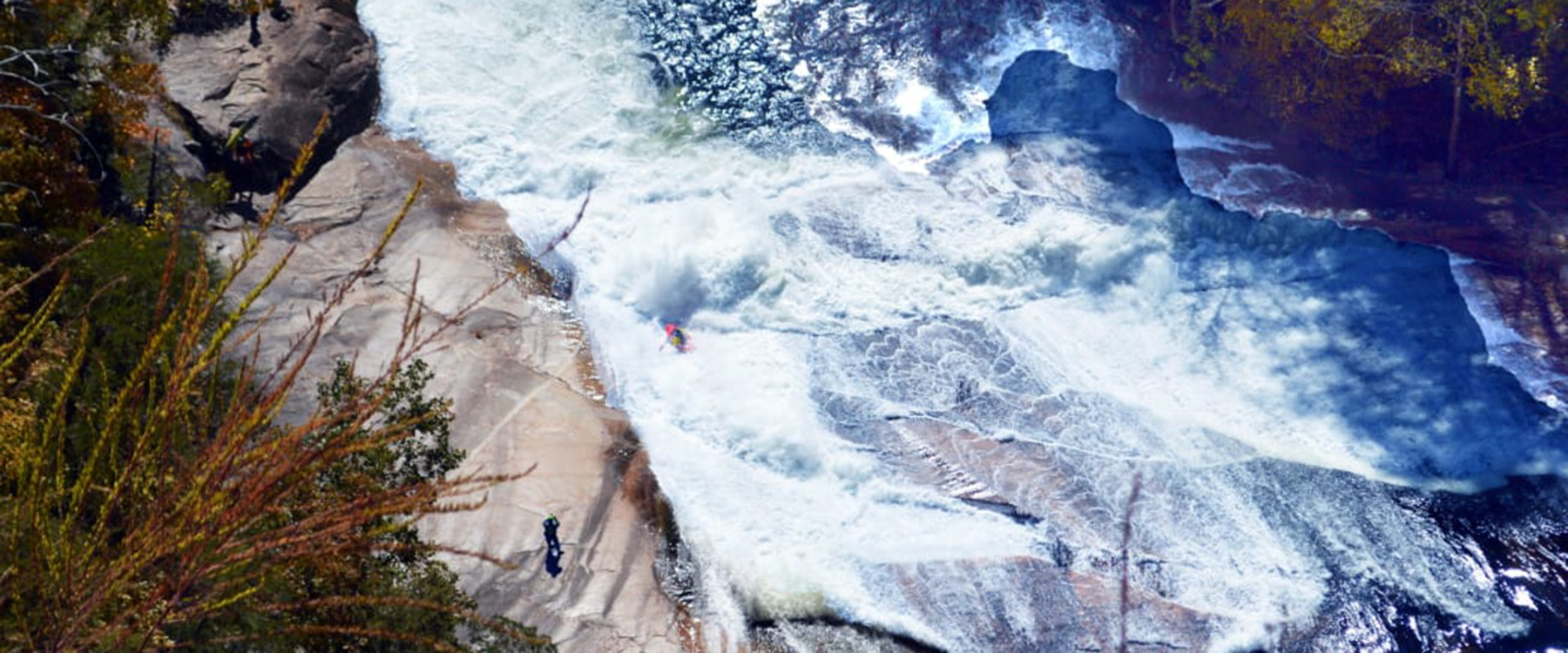Located just a scenic, two-hour drive from Atlanta, Tallulah Gorge is the deepest canyon east of the Mississippi. The two-mile long chasm that dips to nearly 1,000 feet has been sculpted by the Tallulah River over millions of years, and it’s marked by six steep, waterfalls within. The gorge is a magnet for visitors year round, as the North Georgia quartz ravine is a stunning sight for even the most well-traveled adventurer.
But four days each year are special, drawing whitewater enthusiasts from all over the country. The scheduled release of the Tallulah River Dam—two weekends in April and three weekends in November —brings advanced paddlers and kayakers out in droves, all of them bracing for the sudden, thrilling rush of rapids pummeling into the river. The spectacle attracts plenty spectators who watch from above, too.
First dammed in 1912, the Tallulah River releases started back in the 1950s. For decades, whitewater warriors from all over the world have flocked to the grueling class IV and V rapids created by the release. It's one of Georgia's most famous outdoor events, wholly awe-inspiring and uniquely scenic.
While there are several challenging (and rewarding) trails that will guide you directly to the gorge floor, those paths cross the river, which requires a permit from the park—and for safety's sake, permits aren't issued on release days. But to best witness the famed Tallulah River release, you'll want a view from above anyway. Heading out for the dizzying heights and incredible vantage points scattered along the rim of the gorge are an adventure all their own.
Plan your trip by checking the Tallulah Gorge State Park website for official release days, then follow our tips below to ensure a premium viewing spot.
1. Take Your Pick of Impressive Overlooks Along the North Rim Trail

The North Rim Trail, easily accessible from the Interpretive center parking lot, is the most traveled path at Tallulah Gorge State Park. It guides hikers southwest, following the rim of the canyon without descending, making it an easy route for novices—and its breathtaking views make it interesting for folks of all levels. High above the gorge floor, you'll see the suspension bridge below as you begin to head eastbound—here, there's an overlook near one of the towers tightrope walker Karl Wallenda used for his historic 1970 canyon crossing.
For even more spectacular views, keep going. Another overlook comes along once you follow the trail back out, then to the west: Overlook 3 includes a waterfall that gushes with intensified power on release days. Post up there or move on to later overlooks—numbered 4 and 5, with both boasting similarly standout views—that emerge after crossing a creek, just a bit before you hit mile 1 at Highway 441.
2. Go the Extra Mile for a Maximum Vantage from the South Rim Trail
For more spots to see the action and the full spectrum of the gorge, cross the highway (carefully) when the North Rim Trail ends. That's the beginning of the South Rim path, which offers more bird's-eye views of the suspension bridge as well as the Tempesta Falls waterfall at Overlook 8. For more canyon-spanning sights, descend the stairs toward the ninth, penultimate overlook; hike on past a stone bench tucked perfectly beneath the shade of an outcrop to see the 10th and final overlook. (It's another jaw-dropper, of course.)
3. Score a Spot Near the Swaying Suspension Bridge

Because its finale is the gorgeous gorge floor, you won't be able to follow the Hurricane Loop to its full two miles on release days. You will, however, be able to venture out onto the suspension bridge, where a perpetual sway adds extra thrill to standing 80 feet above the raging Hurricane Falls below. Even without descending fully down to the gorge floor, this experience is an earned one—the journey is strenuous and steep. Following the path out from the Interpretive Center, you'll overlap other trails (and be tempted to stop as you pass several alluring viewing spots). Stay on the loop until you get to a series of metal stairs—all 310 of them. The bridge is a favorite for spectators, so be sure to head out early and hike directly to secure your own spot.
4. Take in a Relaxing Roadside View at Retro Tallulah Point
This rustic throwback souvenir and gift shop boasts a long history: It's been a "mountain tradition" since 1912, inviting folks to enjoy free views of the gorge from its picturesque position ever since. Back in the ’70s, locals watched in awe as tightrope walker Karl Wallenda traversed cables between two towers, both visible from the historic covered porch at Tallulah Point. That overlook area has been subtly upgraded and well-maintained, while vintage hand-painted signs, nicknacks and other retro memorabilia further remind visitors of simpler times. The view is a jaw-dropping one, but high enough that you won't see the action too closely without binoculars. Bring a pair along, and be sure to pick up some boiled peanuts and Moon Pies to snack on while you watch.
No matter how you enjoy the whitewater at Tallulah Gorge, you’ll find it to be one of the most rewarding daytrips you can take from Atlanta. Mark your calendars for the next release.
Written by Jhoni Jackson for RootsRated in partnership with Atlanta CVB and legally licensed through the Matcha publisher network. Please direct all licensing questions to legal@getmatcha.com.


Comments